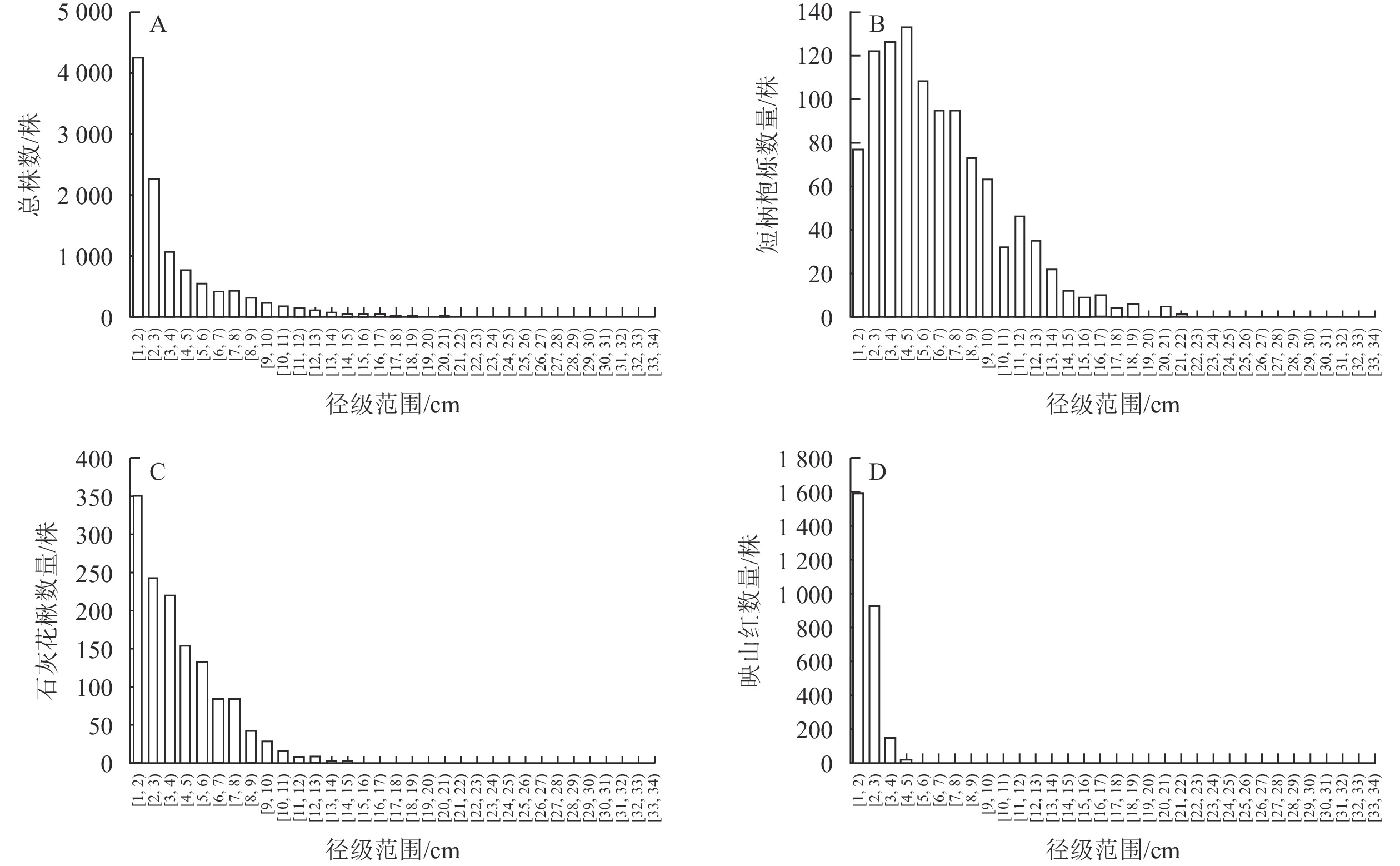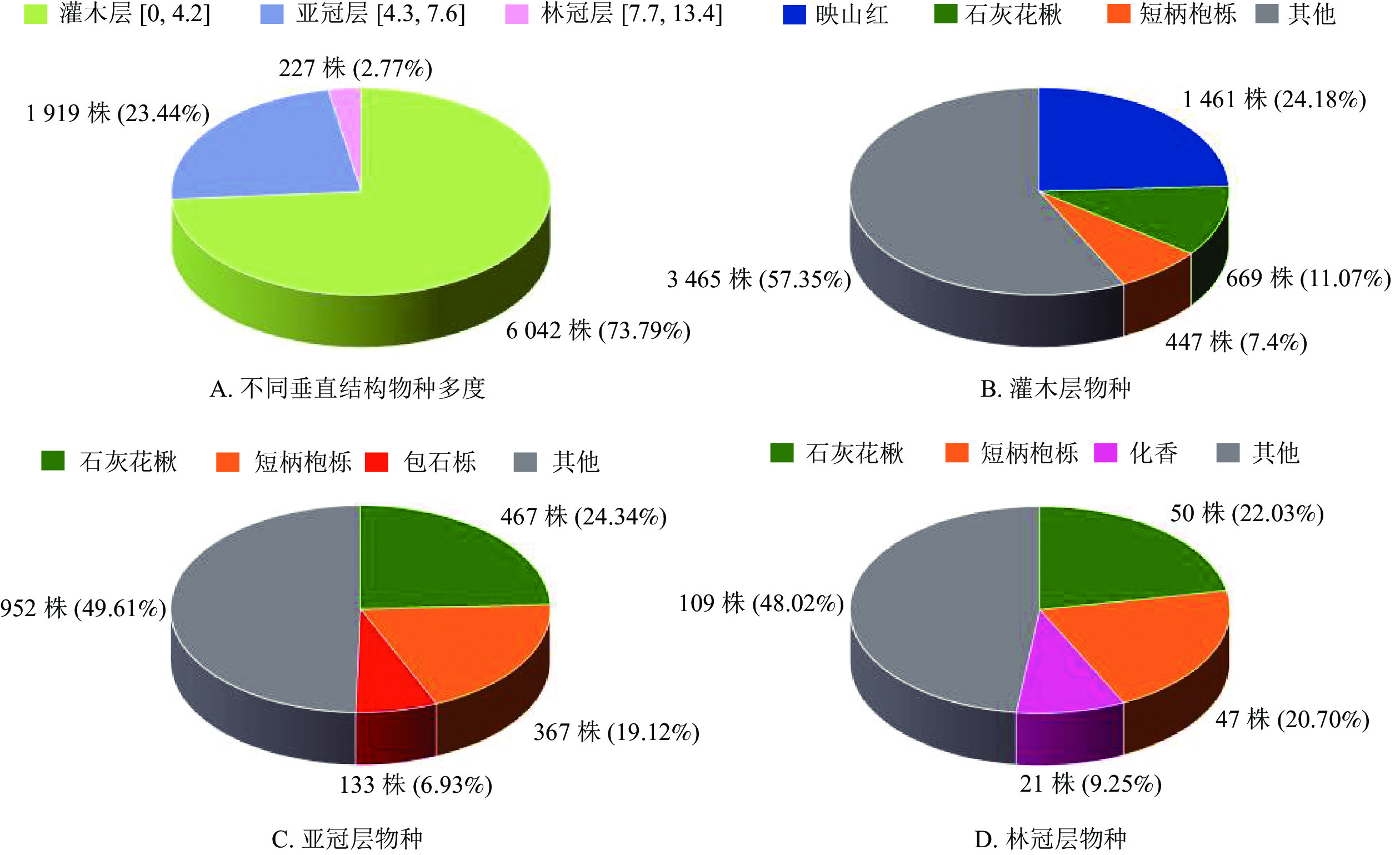-
森林生态系统是地球上最重要的陆地生态系统,不仅直接提供人类生存所必需的各种资源,还在森林固碳和生物多样性保护等方面扮演至关重要的角色[1−3]。在全球气候变暖和降水格局变化的大背景下,森林群落的物种组成、群落结构甚至生态系统功能和生产力都发生了显著改变[1, 4]。落叶阔叶林是北半球一种极为重要的森林类型,对提供生态系统服务并缓解由人类活动引起的气候变化具有关键作用[5]。相较分布于中欧、西欧以及北美东部的落叶阔叶林,东亚地区的落叶阔叶林具有较高的生物多样性和特有物种数量[6]。中国落叶阔叶林是东亚地区落叶阔叶林的重要组成部分,涵盖了从半干旱地区、半湿润地区到湿润地区的广泛气候梯度[7]。一般来说,常绿阔叶林被认为是亚热带地区典型的地带性植被,但在中高海拔的亚热带区域也经常分布一定面积的落叶阔叶林[8]。以往关于亚热带森林的研究很少关注落叶阔叶林,研究中国亚热带地区典型落叶阔叶林群落组成及其结构特征,对于更全面地认识该地区森林生态系统的组成特点和优化森林群落保护策略具有一定的补充作用[9],对完善落叶阔叶林群落研究具有重要意义。
森林群落的物种组成及群落结构特征是群落生态学研究的基础,对阐释物种共存和多样性保护至关重要[10−12]。群落中大多数物种的多度较低,仅有少数物种为常见种[13]。作为森林群落物种组成的另一关键要素,物种的空间分布是物种本身及其与环境相互作用的结果,常被视为探究种群动态和生物多样性维持机制的关键[14]。此外,群落多样性也是生物群落的重要特征,反映了植物群落对环境变化的响应,多样性的变化影响群落结构、功能和演替动态[15]。同时,森林群落在水平和垂直方向上的结构在描述群落特征方面的作用也不容忽视[16],径级结构可以反映林木的胸径、干形等基本状况,以及群落的更新状态和物种与环境之间的相互关系[17],森林群落的垂直分层结构不仅促使光照等生境条件在群落内部发生分化,而且为众多物种的共存提供了丰富的生态位空间,从而影响群落的生物多样性[18−19]。
自巴拿马巴洛科罗拉多岛(Barro Colorado Island)热带雨林大样地建立以来,国内外对森林群落的组成和结构的研究取得了显著进展,在生物多样性维持、物种的空间分布格局以及群落的动态变化等方面展开了卓有成效的研究[20−22]。近20 a来,随着古田山亚热带常绿阔叶林24 hm2监测样地[23]、鼎湖山南亚热带常绿阔叶林20 hm2监测样地[24]和西双版纳热带雨林20 hm2监测样地[25]等的陆续建立,中国目前已建成了29个主样地和近60个面积1~5 hm2的辅助样地(来源于中国科学院生物多样性委员会),与此同时,对温带地区落叶阔叶林群落的研究也在逐步深入,如在中国百花山国家级自然保护区[26]、秦岭长青国家级自然保护区[27]、北京小龙门国家级森林公园[28]、浙江龙王山[29]等自然保护地,也建立了落叶阔叶林的动态监测样地。婺城南山省级自然保护区是目前浙江省内面积最大的省级自然保护区,其中落叶阔叶林是保护区重点保护的森林生态系统,对其中高海拔区域落叶阔叶林物种组成和群落结构的研究尚未见报道。本研究以婺城南山1 hm2固定样地为调查对象,分析样地内物种组成、区系分布、物种多样性、群落径级结构和群落垂直结构等特征,以期为婺城南山省级自然保护区的生物多样性和特色植被资源的保护和动态研究提供基础数据和科学依据。
-
浙江婺城南山省级自然保护区(28°43′56.021″~28°54′8.069″N,119°23′0.081″~119°30′45.113″E)成立于2020年,地处金华市婺城区南山白沙溪源头,以婺城区沙畈乡南部中山区为主,南部与武义县、遂昌县接壤,占地面积为9 532.60 hm2,是目前浙江省内面积最大的省级自然保护区,是保护中亚热带中高海拔落叶阔叶林及穿山甲Manis javanica、黄腹角雉Tragopan caboti和永瓣藤Monimopetalum chinense等珍稀濒危野生动植物的森林生态类型自然保护区。南山保护区的山体多为火山岩覆盖,岩性坚硬,地表残坡积层深厚。气候属于中亚热带湿润季风气候,干湿季分明,夏季高温多雨,冬季温和少雨,适宜林木生长,中高海拔处分布着大面积的落叶阔叶林及针阔混交林,森林覆盖率达94.4%[30]。
-
婺城南山1 hm2长期动态监测样地(以下简称婺城南山样地)选址于保护区内大西坑区域,位于金华婺城区南端,28°46′3.7″N,119°24′30.6″E,海拔为1 012~1 103 m。根据中国森林生物多样性监测网络(CForBio)[31]和《浙江省自然保护地生物多样性长期监测样地建设和调查技术规范(试行)》的建设规范,婺城南山样地以南北、东西方向为边界,用全站仪和森林罗盘仪将整个样地标定成25个20 m × 20 m的样方,在20 m交汇点处设置永久标桩(以西南角为原点编号为0000,向东和向北依次增加,东北角编号为2020,用每个样方东北角编号作为该样方的编号),每个样方划分成16个5 m × 5 m的小样方,在5 m交汇点处插入聚氯乙烯(PVC)管,依据PVC管和标桩对样地进行拉线分隔,于2023年完成样地建设和调查工作。
样地建设完成后,用红色油漆在1.3 m处标记该样地内所有胸径(DBH)≥1 cm的存活个体,以20 m × 20 m样方为基本调查单位,5 m × 5 m小样方为基本测树单元,对样地内所有DBH≥1 cm个体进行定位、物种鉴定、挂牌标记,并调查记录样方号、吊牌号、物种名称、胸径、坐标、树高、枝下高、生长状况等信息,以便进行长期监测。
-
重要值是反映物种在群落中重要性的定量指标,用于比较不同群落间某一物种在群落中的重要性[32],能够反映某一种在群落当中的地位和作用。对婺城南山样地群落中不同植物物种的重要值[33]进行计算,确定群落优势物种。参照HUBBELL等[34]的定义划分稀有种,在本研究中将物种数量为1的物种判定为稀有种。
-
采用Shannon-Wiener多样性指数(H)、Pielou均匀度指数(J)、Simpson多样性指数(D)3个多样性指数[35]来描述南山样地内群落的α多样性。
-
群落的年龄结构以径级结构代替[36],以1.0 cm为起测径级,根据婺城南山木本植物的基本情况,确定以2.5 cm为递增单元,划分成13个区间,最大区间为31.0 cm及以上。并以1.0 cm为作图单元,最大作图区间为33.0~34.0 cm。
测量群落内木本植物的树高,划分林层并统计,林层的具体划分参照天目山常绿落叶阔叶林群落[18],按照婺城南山实际情况将样地群落垂直结构划分为3层:灌木层(0~4.2 m)、亚冠层(4.3~7.6 m)、林冠层(7.7~13.4 m)。
-
根据调查结果统计,在婺城南山样地内DBH ≥ 1 cm的木本植物总计有39科65属97种。其中,裸子植物有三尖杉Cephalotaxus fortunei、杉木Cunninghamia lanceolata和黄山松Pinus taiwanensis 3种,被子植物有36科62属94种,以蔷薇科Rosaceae、杜鹃花科Ericaceae和樟科Lauraceae的木本植物物种数最多,3科种数占总种数的27.84%,其次为冬青科Aquifoliaceae、壳斗科Fagaceae、忍冬科Caprifoliaceae和山茶科Theaceae的木本植物,占总种数的18.56%,有17科含1属1种,占全部种数的17.53%。
样地内有71种落叶阔叶木本植物(73.20%),23种常绿阔叶木本植物(23.71%),3种常绿针叶树种(3.09%)。婺城南山样地内落叶阔叶木本植物物种的比例显著高于常绿阔叶木本植物和针叶类木本植物,样地物种的组成以落叶阔叶树种为主。
-
参考文献[37−39],在婺城南山样地内,木本植物科的热带成分略高于温带成分(热带成分18科,温带成分14科)。植物属的分布以温带成分为主,总计39属(60.00%),其中北温带20属(30.77%);热带植物成分24属(36.92%),其中泛热带11属(16.92%);在样地内有中国特有属和世界分布属各1属(表1)。
分布区类型 科数 属数 世界广布 1. 广布 7 1 热带 2. 泛热带 11 11 3. 东亚及热带南美间断 5 3 4. 旧世界热带 0 3 5. 热带亚洲至热带大洋洲 0 1 6. 热带亚洲至热带非洲 1 1 7. 热带亚洲 1 5 温带 8. 北温带 10 20 9. 东亚及北美间断 2 11 10. 旧世界温带 0 0 11. 温带亚洲 0 0 12. 地中海区、西亚至中亚 0 0 13. 中亚 0 0 14. 东亚 2 8 中国特有 15. 中国特有 0 1 总计 39 65 Table 1. Flora types for woody plants in the 1 hm2 forest plot in Nanshan Nature Reserve
-
样地内DBH≥1 cm的木本植物有11 019株(不包括分枝和根萌),映山红Rhododendron simsii的个体数量达2 686株(占植物总株数的24.38%),石灰花楸Sorbus folgneri和短柄枹栎Quercus serrata的个体数量分别为1 371株(12.44%)和1 073株(9.74%)。由表2可见:多度前10位的物种株数总和为7 793 株(70.72%),多度前20位的物种株数总和为9 616株(87.27%)。另外在对样地物种的统计中发现,三尖杉、乌饭Vaccinium bracteatum、华东野胡桃Juglans mandshurica var. formosana、大叶冬青Ilex latifolia、野山楂Crataegus cuneata、杨梅Morella rubra、构树Broussonetia papyifera、棘茎楤木Aralia echinocaulis、楤木Aralia elata、短尾越橘Vaccinium carlesii、短梗冬青Ilex buergeri、石楠Photinia serratifolia、秀丽槭Acer cordatum、紫果槭Acer cordatum、美丽胡枝子Lespedeza thunbergii subsp. formosa、蓝果树Nyssa sinensis、豆腐柴Premna microphylla等物种在该样地中只有1株,是该群落的稀有种。
种名 多度 显著度 频度 映山红 Rhododendron simsii 2 686 3.15 1.00 石灰花楸 Sorbus folgneri 1 371 16.93 0.88 短柄枹栎 Quercus serrata 1 073 44.52 1.00 山橿 Lindera reflexa 547 1.59 1.00 包石栎 Lithocarpus cleistocarpus 449 38.21 0.88 宜昌荚蒾 Viburnum erosum 399 2.24 0.92 黄檀 Dalbergia hupeana 350 6.84 0.96 化香 Platycarya strobilacea 322 84.47 0.96 山胡椒 Lindera glauca 307 6.17 1.00 粗枝绣球 Hydrangea robusta 289 7.89 0.64 Table 2. Ranking of top ten woody plant abundance in the 1 hm2 forest plot in Nanshan Nature Reserve
婺城南山1 hm2样地落叶阔叶林群落中,重要值(表3)最高的是短柄枹栎,其值为0.115,其重要值受到相对显著度的影响较大,该树种在婺城南山落叶阔叶林群落中处于优势竞争位,其他重要值较高的物种有映山红、石灰花楸、化香Platycarya strobilacea和包石栎Lithocarpus cleistocarpus,重要值分别为0.104、0.086、0.061和0.048,短柄枹栎、映山红和石灰花楸3种落叶树种是该群落的优势木本植物;样地内所有落叶树种的重要值总和为0.709,常绿物种和针叶物种的重要值分别为0.180和0.111,落叶树种的重要值远大于常绿及针叶树种,可见该样地为典型落叶阔叶林。
种名 相对
多度相对显
著度相对
频度重要值 短柄枹栎 Quercus serrata 0.097 0.218 0.030 0.115 映山红 Rhododendron simsii 0.244 0.039 0.030 0.104 石灰花楸 Sorbus folgneri 0.124 0.106 0.026 0.086 化香 Platycarya strobilacea 0.029 0.124 0.029 0.061 包石栎 Lithocarpus cleistocarpus 0.041 0.078 0.026 0.048 钟花樱 Prunus campanulata 0.021 0.052 0.030 0.034 山合欢 Albizia kalkora 0.023 0.051 0.029 0.034 山橿 Lindera reflexa 0.050 0.004 0.030 0.028 杉木 Cunninghamia lanceolata 0.011 0.047 0.020 0.026 红果钓樟 Lindera erythrocarpa 0.014 0.034 0.029 0.025 Table 3. Ranking of important values of top ten woody plants in the 1 hm2 forest plot in Nanshan Nature Reserve
-
婺城南山样地植株空间分布如图1。图1A表示所有物种在样地内的空间分布格局,样地东南区域木本植物个体较为密集,样地西北角区域木本植物分布相对分散,聚集程度相对其他区域较低。从具体生活型看,落叶阔叶物种在各样方中分布范围广,在样地中较为常见;常绿阔叶树种分布范围小于落叶阔叶物种,在样地内分布比较分散,主要集中于样地中部和东部地区;针叶树种在样地中分布范围较小,主要集中于样地北侧和东南角。图1B~F为婺城南山样地中重要值前5位的物种的空间分布图,斑点位置代表该物种在样地中的位置,斑点大小代表植株的胸径大小。总体而言,5个优势种在样地内分布比较广泛,不同物种在样地分布的聚集区域具有一定的差别。除西侧略少见外,短柄枹栎和映山红在样地中总体较常见;石灰花楸和包石栎在样地内分布范围小于短柄枹栎和映山红,具有相似的分布范围;化香在样地中分布范围较小,在部分区域出现聚集分布。
-
物种多样性指标如图2。Simpson多样性指数与Shannon-Wiener多样性指数在整体上具有一致性,在样地东南角的1604和2008样方数值最低,在样地西南方的0808样地数值最高,整体上样地东侧的物种多样性指数略低于西侧。Pielou均匀度指数在大样地的西南部相对较高。物种丰富度在2016样方达到最高(样地东北角),在0808样方和2004样方物种丰富度也相对较高。
-
统计样地内植物胸径,发现样地木本植物胸径总体较小,植株平均胸径为3.66 cm,其中DBH<6 cm和DBH<11 cm的小径级和较小径级植株分别占个体总数的80.78%和95.16%,DBH≥16 cm的植株仅占个体总数的0.83%。
婺城南山样地内群落径级结构整体呈倒“J”型(图3A),最大的胸径数值为32.3 cm,该物种为杉木。物种数量在1~6 cm的胸径区间内存在较大程度的下降,但整体上并未出现明显的断层。3种优势物种中,短柄枹栎(图3B)和石灰花楸(图3C)在不同径级结构中都比较常见,97.80%的映山红胸径在3.5 cm以下(图3D)。短柄枹栎和石灰花楸在样地中表现出小乔木的特征,在群落中幼苗或幼树的储备量比较充足,较小或较大径级的植株都比较充裕,映山红则表现出灌木的性状,较大径级植株数量较少。
-
排除受地形或外力因素导致倾斜角度过大或倒伏的木本植物,用于垂直结构分析的植物共8 188株。婺城南山样地中树高范围在灌木层的植物有6 042株(73.79%),其中,映山红、石灰花楸和短柄枹栎的数目较多,分别占该区间植物数的24.18%、11.07%和7.40%(图4A和图4B)。婺城南山样地中树高范围在亚冠层的植物有1 919株(23.44%),其中,石灰花楸、短柄枹栎和包石栎分别占所在林层植株数量的24.34%、19.12%和6.93%,在亚冠层中数量较多(图4A和图4C)。处于林冠层的植物总计227株(2.77%),植株总数相对较少,其中,石灰花楸、短柄枹栎和化香3种落叶树种分别占所在林层植株数量的22.03%、20.70%和9.25%(图4A和图4D)。
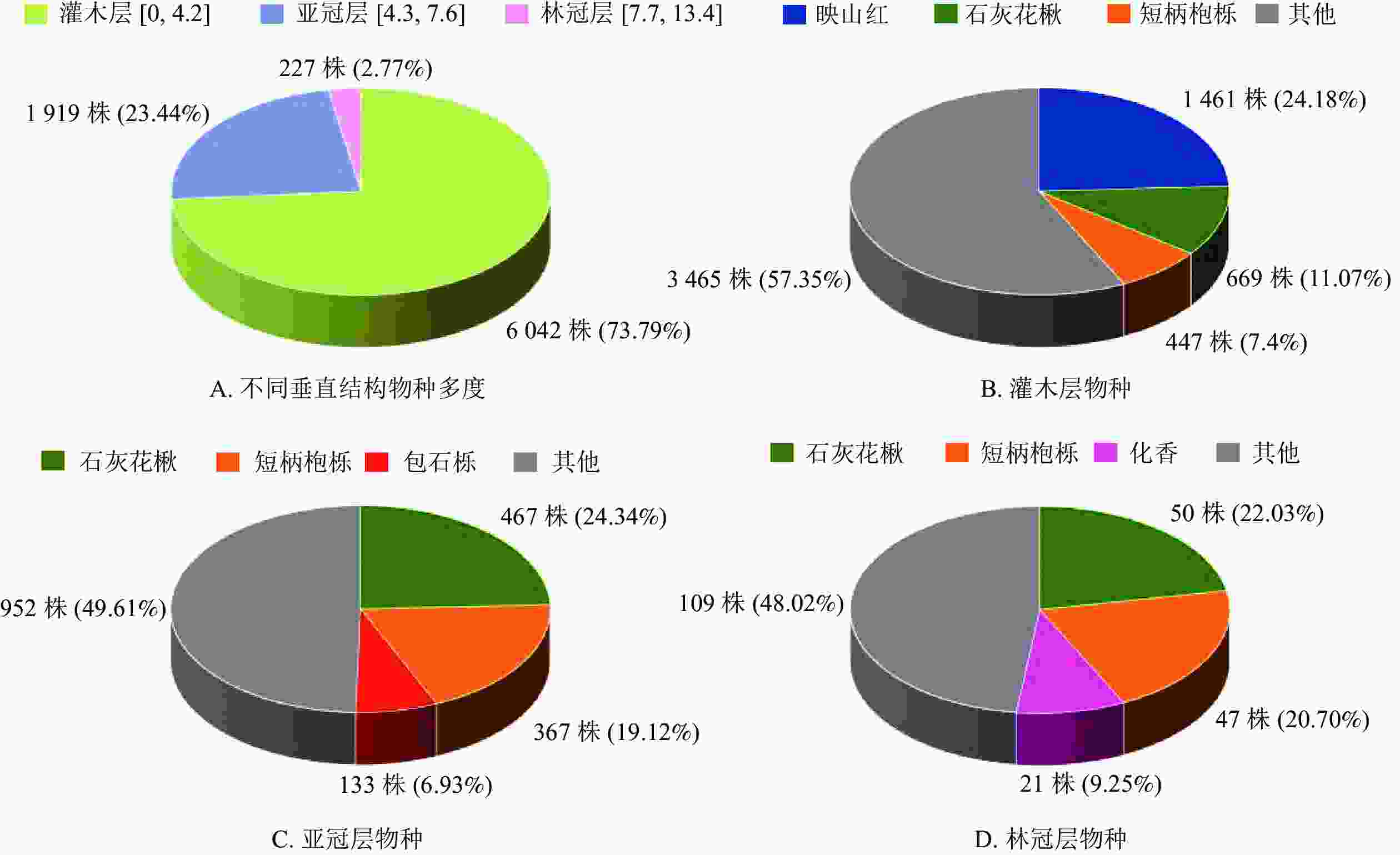
Figure 4. Distribution of species vertical structure in the 1 hm2 forest plot in Nanshan Nature Reserve
婺城南山样地大部分木本植物处于灌木层,其中,映山红和短柄枹栎在灌木层中的数量较多,可认为是灌木层中的优势种;在该群落的亚冠层中,石灰花楸和短柄枹栎处于优势地位;群落的林冠层中,以石灰花楸、短柄枹栎和化香为主。调查发现,样地中下坡位还发现一定数量的林间层藤本植物,如密花崖豆藤Millettia congestiflora、中华猕猴桃Actinidia chinensis、葛藤Argyreia pierreana、大芽南蛇藤Celastrus gemmatus等,其中,密花崖豆藤相对较常见。
-
经调查统计发现:婺城南山样地内共有木本植物39科65属97种,表明该群落的生物多样性丰富。群落中落叶物种、常绿物种和针叶物种的重要值分别为70.91%、17.95%和11.14%,意味着该群落为典型的落叶阔叶林。与调查方法类似且纬度接近的湖北神农架25 hm2样地比较,神农架样地平均密度仅为2 442株·hm−2[9],而婺城南山样地的木本植物总计11 019 株,植株密度为神农架样地的4.5倍。从数据统计层面分析,神农架样地以大径级米心水青冈Fagus engleriana和锐齿槲栎Quercus aliena var. acuteserrata为主要建群种[40],群落发育时间较长,植株个体胸径较大,其竞争强度受胸径影响较大[41],进而呈现平均密度小于婺城南山样地的结果。此外,婺城南山样地生物多样性程度可能与样地地理位置与气候条件有关。金华南山整体位于东部季风区[42],样地降水丰富,地形、地貌受海拔影响复杂多样,生境异质性高,为维持生物多样性提供了基础条件。
从物种的区系成分来看,婺城南山样地内物种的温带成分是热带成分的1.63倍,温带分布属的比例显著高于热带,和纬度接近的古田山24 hm2大样地[43]的属级成分存在明显区别。这可能和2个样地的植被类型和物种组成有关。古田山样地植被为原生的常绿阔叶林,物种以常绿阔叶种类为主,且样地海拔相对较低,而南山1 hm2样地地处海拔为1 012~1 103 m 的山脊,较高的海拔使得婺城南山样地气温低于古田山样地,植被为典型山地落叶阔叶林。婺城南山样地物种区系成分以温带占优的现象,可能反映了植被分布的垂直地带性特征[44]。
木本植物的径级和垂直结构揭示了群落的年龄特征,也反映了可能的演替历程和影响因素[45]。婺城南山样地中,中小径级的个体在群落中占明显优势,和纬度相近的百山祖样地[46]相比,径级分布总体规律类似(均为倒“J”型),说明婺城南山群落在一定时间内具有良好的自我更新能力,但婺城南山样地的木本植物胸径普遍小于百山祖样地。
从垂直结构看,婺城南山样地73.79%的植株处于灌木层,23.44%的植株处于亚冠层,说明婺城南山样地木本植物树高总体偏矮小,这与浙江乌岩岭国家自然保护区的结果[47]存在差异,在乌岩岭保护区内,随着树木的增高,乔木树种占比先增加而后缓慢下降。径级结构与垂直结构均反映了婺城南山落叶阔叶林群落树龄结构偏小的特点,演替正处于初期阶段,这可能是受到人为因素干扰的结果。从婺城南山样地的周边情况看,样地南侧的遂昌郑岗岭林场育有大面积长势良好的大径级杉木林和少量的黄山松,北侧不远处有少量胸径大于20 cm的甜槠Castanopsis eyrei和木荷Schima superba,周边沟谷地带零星分布有杉木,推测婺城南山样地可能在早期是以甜槠和木荷为优势种的群落,原生林遭遇人为干扰破坏(人为砍伐)后,树龄结构较大的树种数量减少,落叶树种逐步占据优势,演变为落叶阔叶林。现阶段,婺城南山样地中,短柄枹栎、石灰花楸等落叶物种在林冠层、亚冠层和灌木层的重要值占比较高,推测该群落在一定时期内仍将继续维持落叶阔叶林原貌,未来是否有可能向常绿落叶阔叶混交林或其他植被类型演替,尚需进一步的动态观察和研究。
-
浙江婺城南山森林样地是典型的落叶阔叶林群落,群落物种多样性丰富。虽然科的分布温带与热带比例接近,但是属的分布温带成分占据明显优势。群落径级结构呈现倒“J”型,群落中物种径级总体偏小,植株密度较大。垂直方向上,灌木层和亚冠层占优势,分层不明显。婺城南山落叶阔叶林的物种组成和群落结构在中亚热带中高海拔地区有一定的代表性。
-
感谢婺城南山省级自然保护区管理中心,浙江大学于明坚、毛志斌,浙江省森林资源监测中心陈征海,以及浙江师范大学杨依丹、柴澎涛、金航锋、叶永强、沈彬宇、郑林尧、汪骋翼等在样地选择、建设和调查过程中给予帮助。
Species composition and community structure of deciduous broad-leaved forest in Wucheng Nanshan Nature Reserve, Zhejiang Province
doi: 10.11833/j.issn.2095-0756.20240442
- Received Date: 2024-07-10
- Accepted Date: 2024-11-18
- Rev Recd Date: 2024-11-14
- Available Online: 2025-01-20
- Publish Date: 2025-02-20
-
Key words:
- Nanshan Nature Reserve /
- broad-leaved deciduous forest /
- species composition /
- floristic distribution /
- community structure
Abstract:
| Citation: | TANG Ruiqi, WU Qi, ZHENG Rong, et al. Species composition and community structure of deciduous broad-leaved forest in Wucheng Nanshan Nature Reserve, Zhejiang Province[J]. Journal of Zhejiang A&F University, 2025, 42(1): 23−33 doi: 10.11833/j.issn.2095-0756.20240442 |




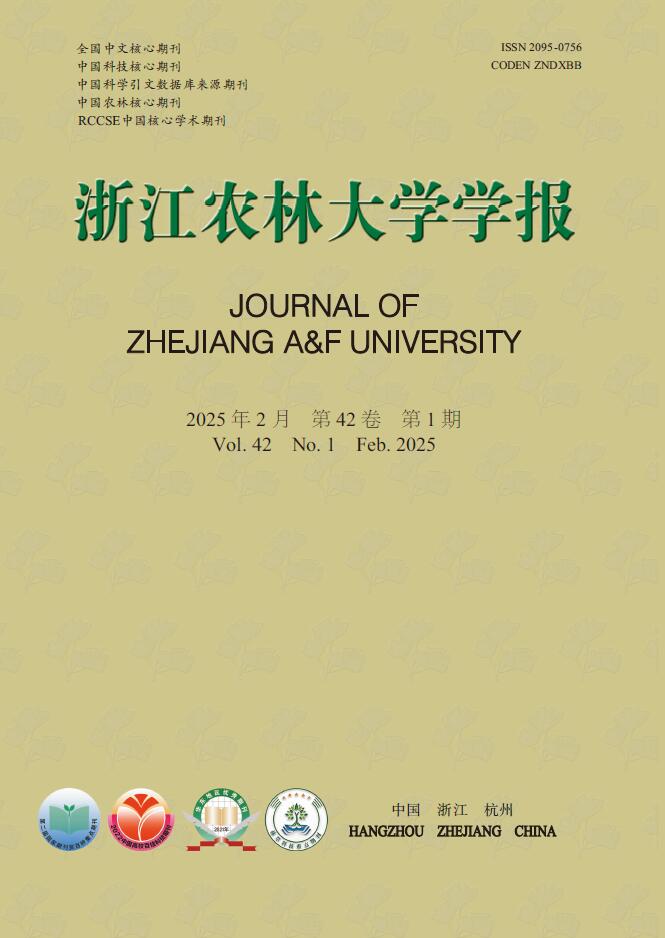


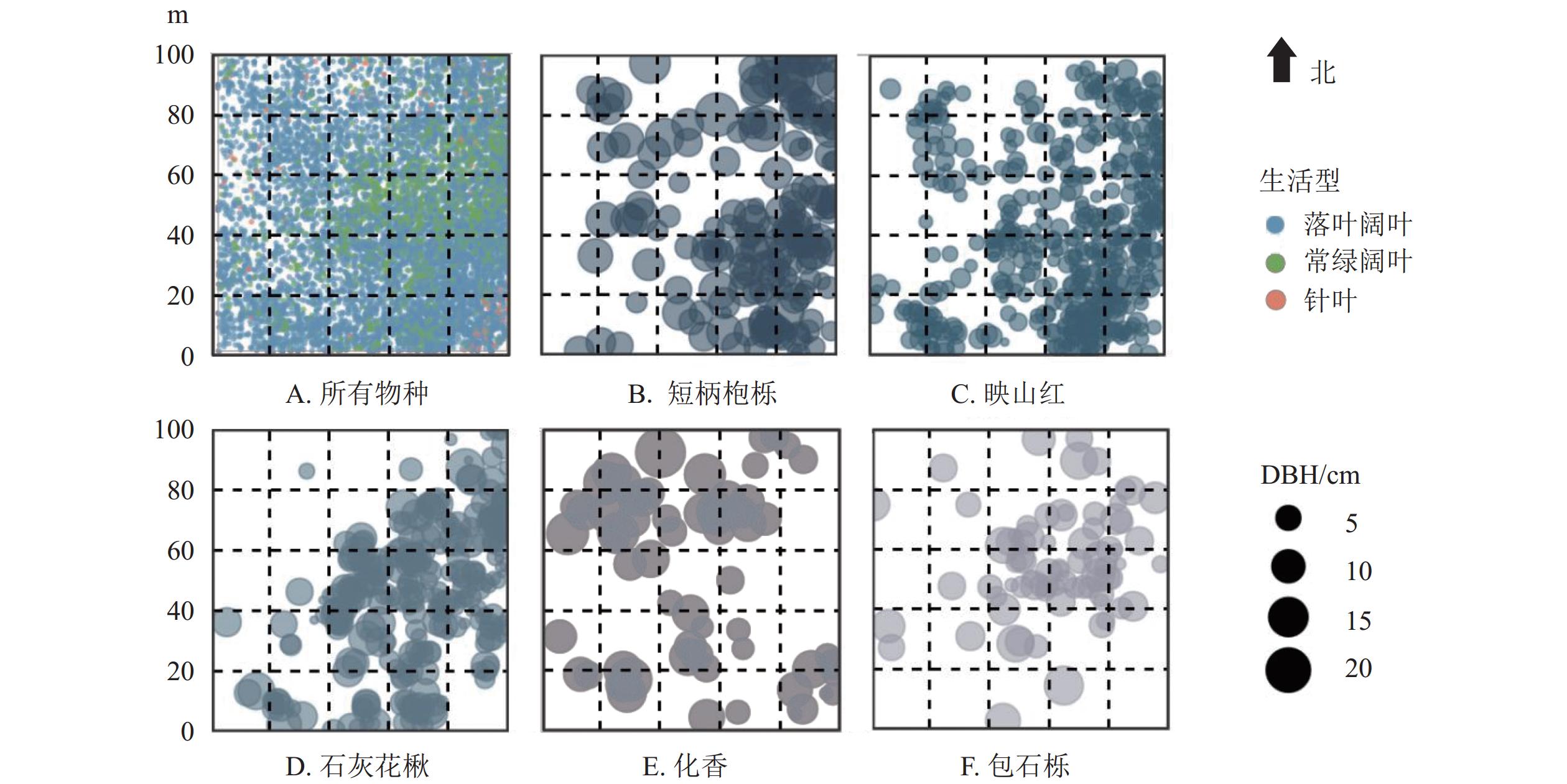




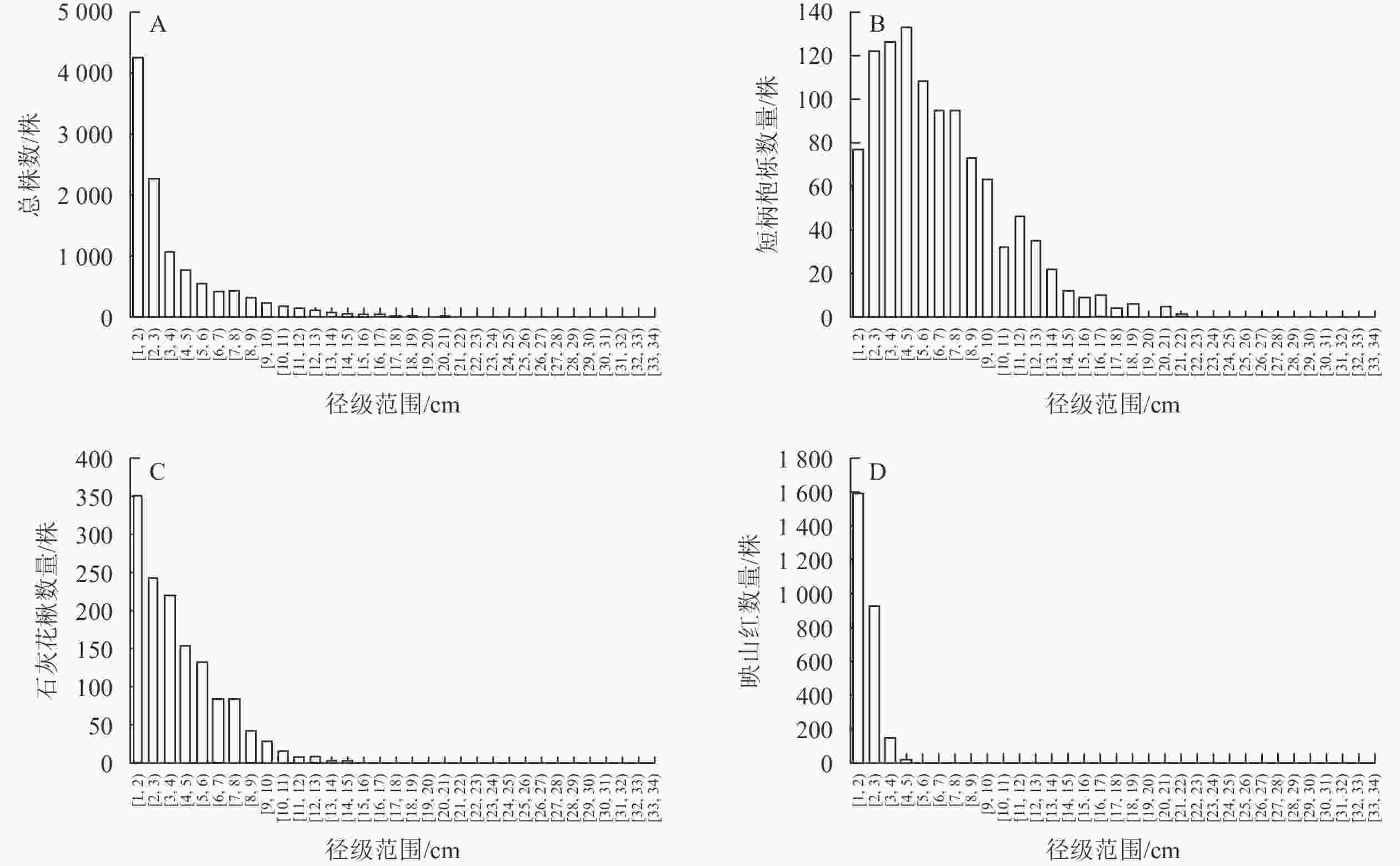
 DownLoad:
DownLoad:

